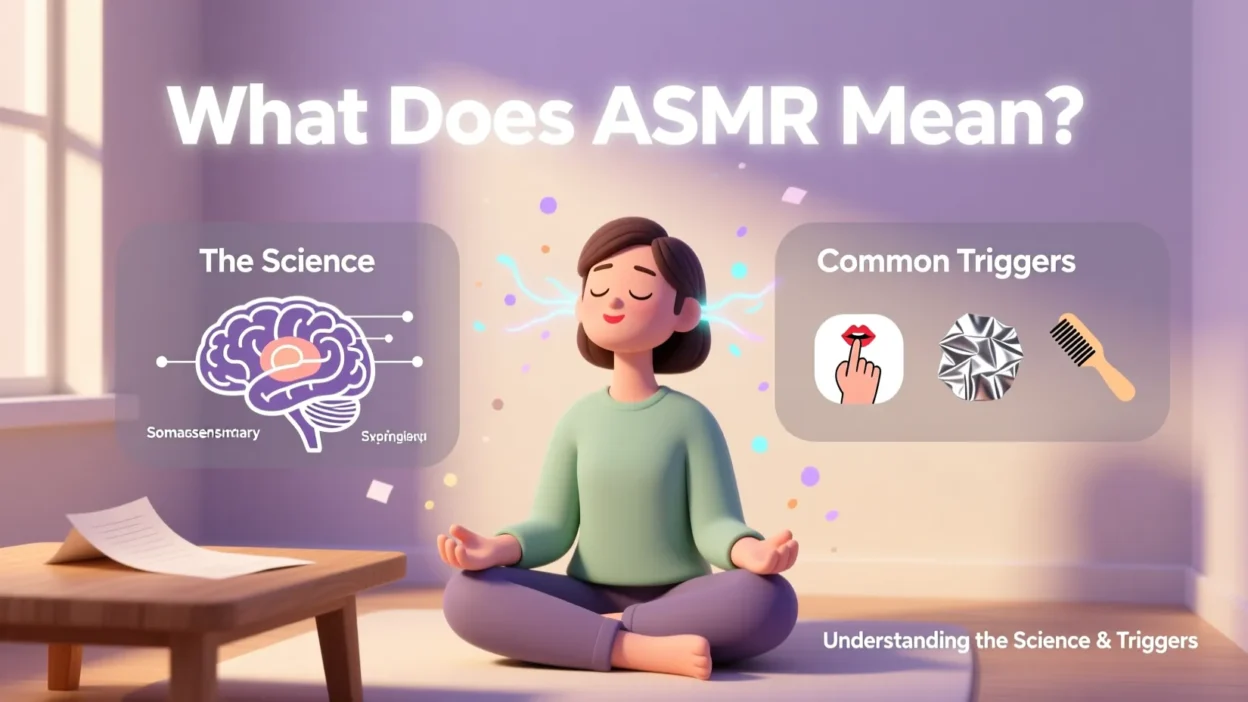Have you ever felt a soft, pleasant tingling sensation crawl up your scalp when someone whispers close to your ear or taps gently on a surface? That spine-tingling calm you can’t quite explain has a name — ASMR, short for Autonomous Sensory Meridian Response.
In this comprehensive guide, you’ll discover what ASMR meaning truly is, how it works in the brain, why certain trigger sounds cause pleasant chills, and how you can use it for relaxation, stress relief, and better sleep.
Understanding ASMR: The Full Meaning and Description

The full form of ASMR is Autonomous Sensory Meridian Response. Each word in that phrase gives you a clue about what’s happening:
- Autonomous means it occurs naturally — you can’t force it, your body reacts on its own.
- Sensory refers to your senses — primarily hearing and sight.
- Meridian signifies a peak or climax of feeling.
- Response describes the body’s reaction to stimuli.
In simpler terms, ASMR is a relaxation response triggered by gentle sounds, movements, or visual cues that cause a pleasant tingling sensation, often beginning at the scalp and flowing down the spine.
People often describe this feeling as brain tingles, audio buzz, or even soft shivers that produce deep calm and emotional comfort. It’s the sensory equivalent of a warm hug — subtle yet powerful.
The Science Behind ASMR and the Brain’s Relaxation Response
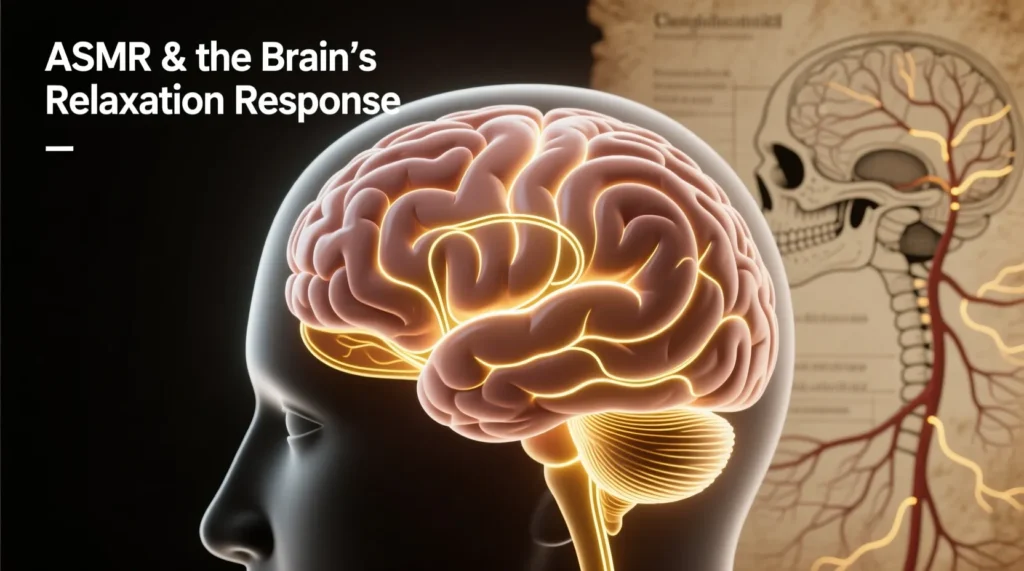
ASMR isn’t just an internet trend — science confirms it creates real physiological and neurological effects.
How Your Brain Reacts
When you experience ASMR, your brain activates regions involved in:
- Reward processing — linked with dopamine release and positive emotion.
- Social bonding — similar to the calm you feel during gentle touch or care.
- Relaxation and sleepiness — connected to slower brainwave activity and decreased heart rate.
This explains why ASMR videos help many people unwind, fall asleep faster, or ease anxiety. It’s not imaginary — your brain is literally relaxing.
Body Responses During ASMR
| Biological Response | Description | Impact |
|---|---|---|
| Heart Rate Drop | Up to 3–4 beats per minute decrease | Promotes calm and reduces tension |
| Skin Conductance | Slight increase in response to tingles | Shows emotional arousal |
| Muscle Relaxation | Reduced micro-tension | Easier to rest or sleep |
| Brain Activation | Enhanced temporal and frontal lobe activity | Links to emotional empathy |
Why It Feels So Good
The tingling sensation acts as a mini-reward. Think of it as your body saying, “This is safe, keep listening.” That’s why you crave more once you find your favorite ASMR triggers — your nervous system associates them with comfort and safety.
Common ASMR Triggers: Sounds That Make You Tingle
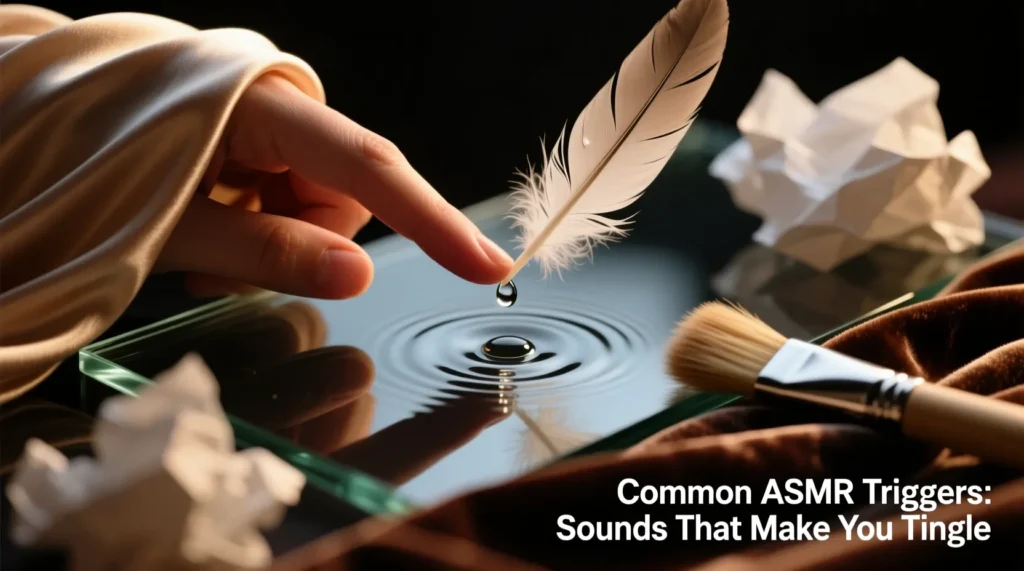
Not every sound works for everyone. But across millions of listeners, a few categories repeatedly cause the ASMR sensation.
Auditory Triggers
- Whispering — soft, close-mic voices create intimacy and safety.
- Soft speaking — gentle tone without whispering; often story-based or instructional.
- Tapping sounds — rhythmic fingertip or nail taps on wood, glass, or plastic.
- Crinkling noises — the rustle of paper, foil, or plastic wrapping.
- Brushing sounds — microphone brushing or hair brushing near the mic.
Visual Triggers
- Personal attention roleplays — pretend haircuts, spa treatments, or doctor visits.
- Slow hand movements — repetitive, deliberate gestures that soothe visual focus.
- Organizing and cleaning — folding, sorting, or painting in slow rhythm.
Combined Triggers
Many ASMR creators blend auditory stimulus with visual cues, intensifying the sensory response. For example, whispering while brushing a camera lens gives the illusion of real-life touch.
| Trigger Type | Example | Typical Sensation |
|---|---|---|
| Whispering | “Can you hear me?” softly in each ear | Scalp and ear tingles |
| Tapping | Fingertips on glass or wood | Buzzing along spine |
| Crinkling | Wrapping paper or plastic bag | Slow-building comfort |
| Roleplay | “I’ll check your eyes now” | Emotional warmth, calm |
| Visual focus | Slow folding towels | Hypnotic relaxation |
Tip
Experiment. Everyone’s triggers are unique. You may respond to tapping sounds but not whispering, or prefer visual triggers over sound. The joy of ASMR is finding what works specifically for your sensory makeup.
The Psychology of ASMR: Why It Works So Deeply
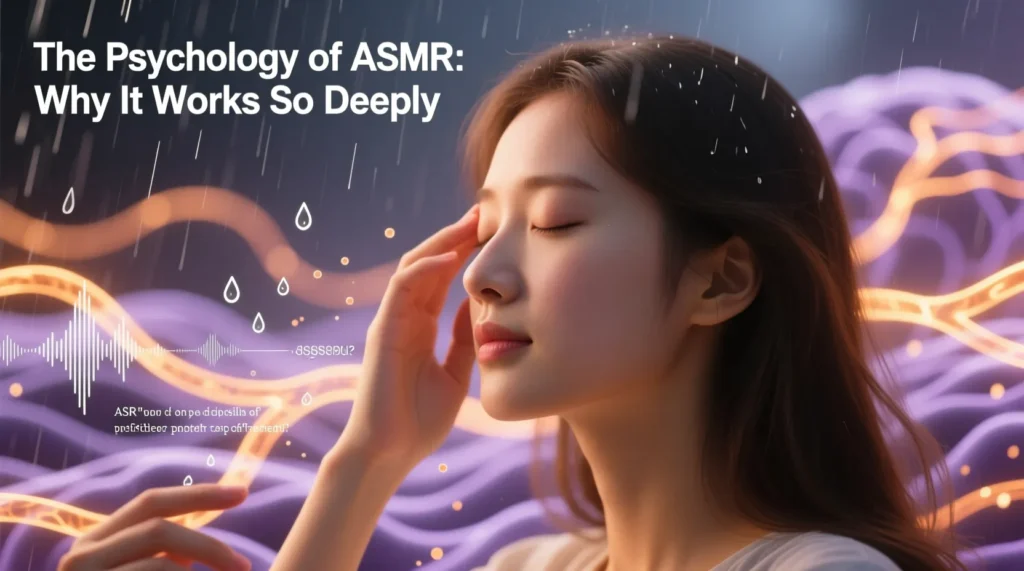
ASMR is a fascinating case of multisensory perception and embodied cognition — your body reacts as though you’re experiencing real touch or closeness.
Cognitive and Emotional Effects
- Affective semantics: The brain links soothing sounds with safety and empathy.
- Auditory imagery: Sounds trigger vivid internal sensations.
- Emotion classification: Listeners report calm, serenity, and light euphoria.
- Mood regulation: Many describe using ASMR to manage anxiety or low mood.
The Empathy Connection
Personal attention triggers — like roleplay ASMR — mimic the feeling of being cared for. That connection releases oxytocin-like effects, enhancing trust and calm. It’s digital comfort with real emotional resonance.
ASMR vs. Meditation
| Feature | ASMR | Meditation |
|---|---|---|
| Focus | External (sounds, visuals) | Internal (breath, thoughts) |
| Goal | Sensory relaxation | Mental stillness |
| Tools | Audio/video triggers | Silence or guidance |
| Feeling | Tingles, comfort | Presence, clarity |
Both share outcomes: reduced stress, lower anxiety, and improved sleep — but through different sensory pathways.
Using ASMR for Sleep Aid, Stress Relief, and Mindfulness
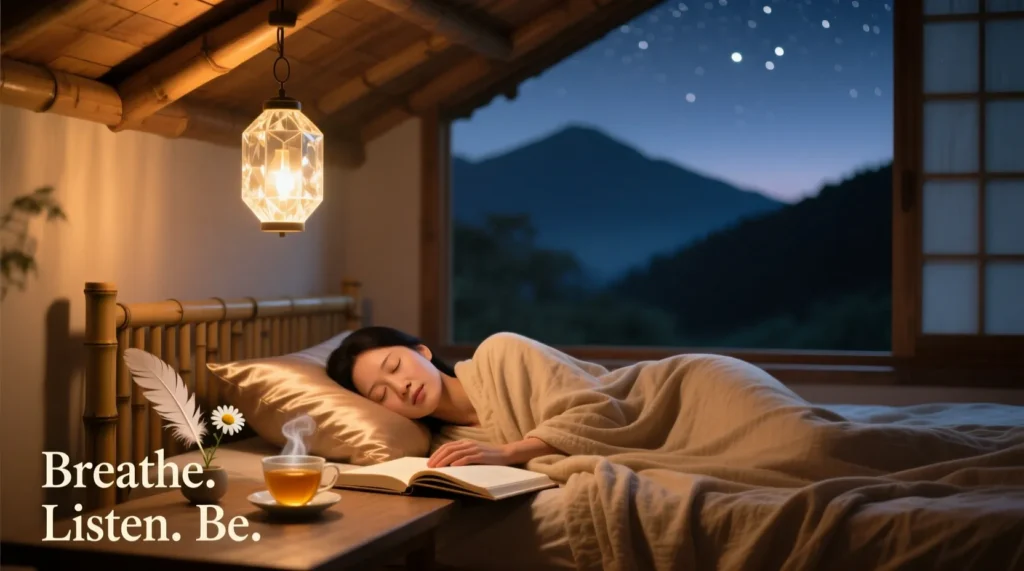
For millions, ASMR is more than a curiosity — it’s a nightly ritual for better rest.
ASMR for Sleep
Here’s how it helps:
- Slows the heart rate, encouraging the body to unwind.
- Shifts attention away from racing thoughts.
- Encourages drowsiness through rhythmic sounds and repetition.
Best way to use it for sleep:
- Choose low-volume relaxation videos or binaural audio.
- Play them in bed using headphones.
- Keep lighting soft and avoid screens after starting.
- Don’t chase tingles — just focus on the calming effect.
ASMR for Stress Relief
If anxiety builds during your day, ASMR can help:
- Whispering and tapping act like auditory mindfulness.
- It engages para-linguistic cues (tone, pace, emotion) that soothe your nervous system.
- Repeated sessions train your brain to associate those triggers with calm.
Quick stress-relief routine:
- Sit comfortably and play 5–10 minutes of your favorite trigger.
- Close your eyes and notice any body relaxation or tingling sensation.
- Combine it with deep breathing for amplified results.
ASMR for Mindfulness
ASMR aligns naturally with mindfulness practice. Both promote sensory awareness and non-judgmental focus.
Try this short ASMR mindfulness session:
- Play a video with gentle tapping sounds or soft speaking.
- Inhale slowly through your nose, exhale through your mouth.
- When tingles arise, simply observe them — don’t chase them.
- Let the rhythm of sound anchor your attention in the present.
Inside the ASMR Community: Artists, Viewers, and Evolution
The ASMR community is vast and creative. From YouTube to TikTok, ASMR content dominates relaxation trends.
Who Creates ASMR?
These creators — often called ASMRtists — specialize in designing relaxation videos and audio therapy experiences. Their tools include:
- Binaural microphones to capture 3D sound.
- Soft-spoken narration or whispering therapy.
- Personal attention roleplays mimicking spa visits, doctor exams, or conversations.
Viewer Motivations
People turn to ASMR content for:
- Better sleep quality
- Emotional regulation
- Escape from digital overload
- Sensory enjoyment and curiosity
Evolution of ASMR Content
| Era | Platform Focus | Typical Format |
|---|---|---|
| Early 2010s | YouTube | Whisper and tapping videos |
| 2015–2019 | Twitch & Podcasts | Live ASMR streams |
| 2020s | TikTok & Shorts | Quick, visual triggers |
| Present | Multi-platform | 3D audio, immersive roleplays |
The genre keeps expanding, blending sound therapy, mindfulness, and digital intimacy.
Practical Guide: How to Experience ASMR Effectively
Ready to try ASMR yourself? Here’s a tested, step-by-step guide.
Step 1: Prepare Your Environment
Find a quiet space. Dim the lights. Put on quality headphones — they’re essential for binaural sound.
Step 2: Choose Your Triggers
Start with popular categories: whispering, tapping, brushing, or personal attention.
Use trial and error to find your sweet spot.
Step 3: Observe Your Reaction
Notice where you feel tingles — scalp, neck, shoulders?
If no tingles come, focus on the sense of calm instead.
Step 4: Track and Adjust
Keep a small ASMR journal:
| Date | Trigger | Duration | Effect (1–10) | Notes |
|---|---|---|---|---|
| Oct 21 | Whispering | 15 min | 8 | Sleepy and calm |
| Oct 22 | Tapping | 10 min | 5 | Mild tingles |
| Oct 23 | Roleplay | 20 min | 9 | Deep relaxation |
Patterns will emerge — your body teaches you what works.
Step 5: Integrate Into Your Routine
Use ASMR for bedtime or midday decompression.
Think of it like brushing your mental hair — a simple act that keeps your mind smooth.
The Potential and Limits of ASMR
While ASMR brings powerful benefits, it’s not a miracle cure.
Strengths
- Provides immediate calm without medication.
- Non-invasive and accessible — anyone with a phone can try it.
- Encourages mind-body awareness and empathy modeling.
Limitations
- Not everyone experiences brain tingles.
- Research is still evolving; exact mechanisms aren’t fully mapped.
- Some sounds may trigger misophonia in sensitive individuals.
- Overuse as a sleep aid can create dependency.
The Future of ASMR
- Integration into mental-health apps and virtual therapy.
- Use of AI-driven sound design to tailor triggers to users.
- Greater understanding of neurosemantic association — how language and sound combine to produce emotion.
Conclusion: What ASMR Meaning Offers You
ASMR is more than an internet phenomenon — it’s a gentle bridge between sound, emotion, and relaxation.
It shows how subtle sensory cues can change mood, promote stress relief, and help with sleep.
To recap:
- ASMR stands for Autonomous Sensory Meridian Response — a calm-inducing tingling sensation triggered by specific sounds or visuals.
- It stimulates real brain and body reactions, leading to relaxation, pleasure, and mindful calm.
- You can explore it through whispering, soft speaking, tapping sounds, or personal attention roleplays.
- Whether you’re chasing the pleasant chills or simply the quiet calm, ASMR offers a scientifically backed form of sensory comfort.

